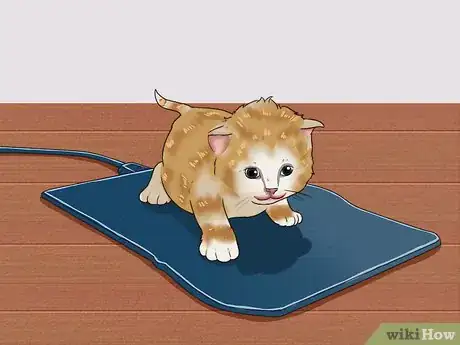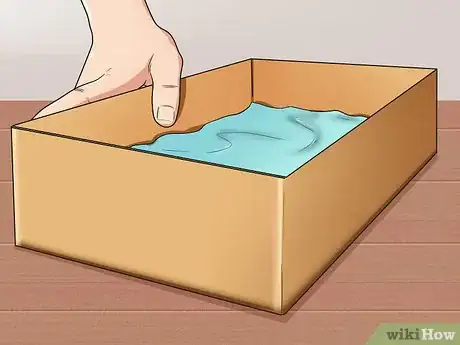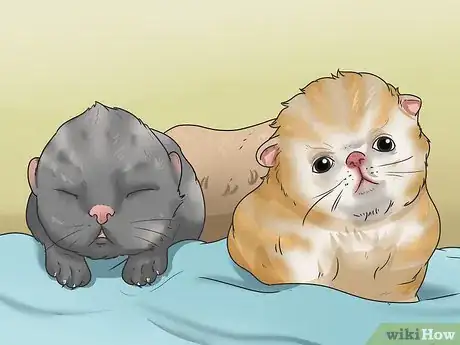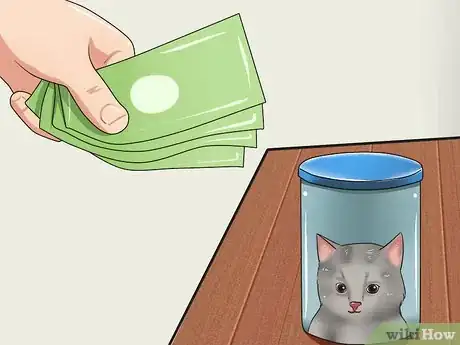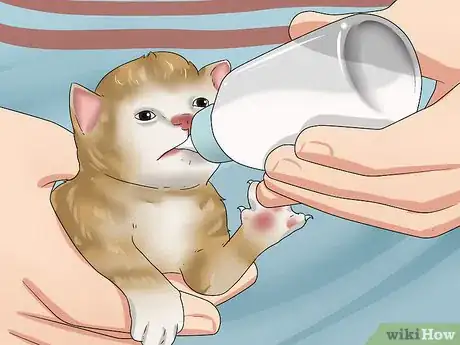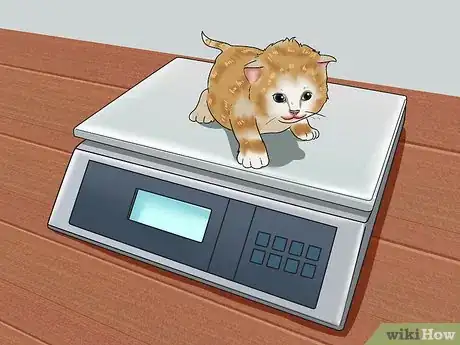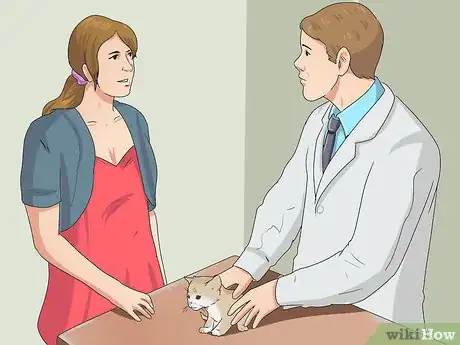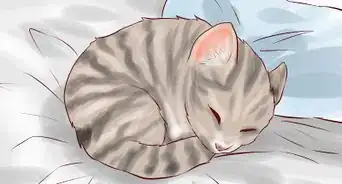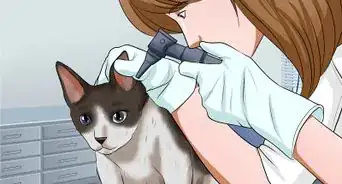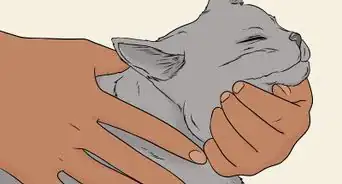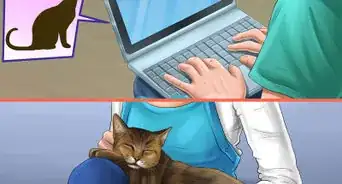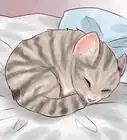This article was co-authored by Carrie Seay, MS-CABAC, KPA-CTP, CBCC-KA. Carrie Seay is a Feline Behavior Consultant and the Owner of Carrie Pawpins based in Phoenix, Arizona. With over a decade of experience, she specializes in working with cat owners to prevent and eliminate cat behavioral issues. Carrie holds a Bachelor’s degree in Biology from Northern Arizona University and a Master’s degree in Companion Animal Behavior Analysis & Counseling from The American College of Applied Science. She has multiple certifications from well-known training programs like Karen Pryor academy.
wikiHow marks an article as reader-approved once it receives enough positive feedback. This article has 22 testimonials from our readers, earning it our reader-approved status.
This article has been viewed 642,292 times.
Taking care of newborn kittens that have been orphaned can be very rewarding, but very challenging. Humans are poor substitutes for a mother cat, and care and feeding of very young kittens is a full-time job. Unfortunately, sometimes a mother cat is unwell and unable to nurse, or else she rejects the kittens, in which case they need to be hand-reared. Before you try to hand-rear orphaned kittens, call your local animal shelters and vets to try to locate a nursing mother cat substitute. Some will accept, feed and bathe orphaned kittens, and this is the best thing you can do to ensure they survive. If not, create a nurturing environment and learn how to properly feed and care for kittens less than three weeks old.
Steps
Creating a Nurturing Environment
-
1Learn how to handle the kittens. Always take care to wash your hands before and after handling the kittens. They may be carrying diseases or be susceptible to germs and bacteria that you've picked up. When you do pick up the kittens, pick them up carefully. Always check to make sure they feel warm, by seeing if the pads of their feet feel cold. Chances are, they'll start crying if they're cold.[1]
- If you have other pets, make sure to keep them separate from the orphaned kittens for at least 2 weeks. Don't let them share litter boxes, food, or water bowls, since these could spread disease.
-
2Keep them warm. Neonatal kittens (under 2 weeks old) cannot regulate their body temperature and usually keep warm by snuggling up to the mother. Since they can't do this, get a heating pad designed for puppies or kittens. Place the kittens on the heating pad, making sure to avoid direct contact with the pad if there's no fleece cover on it. If there's no cover, wrap a towel around it.[2]
- Kittens should never be directly exposed to the heating pad, since they may get localized burns or overheat.
- You can also use a hot water bottle wrapped in a towel, but check it frequently to make sure it's still warm (around 100 degrees).
Advertisement -
3Make a soft bedding spot. Place a box or cat carrier in a quiet, isolated part of your house. The room you put it in should be warm and draft-free, away from any other pets. Set a towel inside the box to make a cozy spot for the kittens to rest.[3] You should also cover the box or carrier with a towel to keep it warm.
- Make sure not to cover air holes in the box or cat carrier to prevent suffocation.[4]
-
4Keep the kittens together. You don't need separate boxes or carriers for each kitten. Place them all in the same soft bedding spot. This will also help keep them warm and comforted. Ensure that there is enough room for the kittens to move around.
- For instance, the kittens should be able to move to the edges of a heating pad if they're starting to overheat.
Feeding the Kittens
-
1Buy powdered cat milk replacer. Buy powdered cat milk replacer, like Cimicat, from the vet clinic, major pet stores, or the internet.[5] This is the cat equivalent of infant formula, with the same composition milk from the kittens' mother. Do not feed cow's milk since the sugar, or lactose, will likely upset the kittens' stomachs.[6]
- If you don't have milk replacement and the kittens are hungry, offer some boiled water that has been cooled. Use a dropper or syringe, until you can get to the vet clinic or pet store. The water keeps the kittens hydrated and won't cause upset stomachs.[7]
-
2Prepare to feed the kittens. Sterilize the bottle and nipple in boiling water, then let them cool completely on a clean towel.[8] Mix up the milk replacement formula using a little whisk to get the lumps out. You should warm the milk up to 95 - 100 degrees before feeding it to the kittens. As a final check, drip a few drops onto the underside of your wrist to make sure it's not too hot.[9]
- Always make sure the kittens themselves are warm before feeding them. Never feed a kitten whose temperature is less than 95 degrees. This could cause aspiration pneumonia which makes it difficult to breathe and may even be fatal.[10]
-
3Correctly position the kittens and bottles for feeding. Never hold a kitten and feed it like a human baby. Instead, keep the kitten's feet down and it's head straight, as though she's nursing from her mother. Hold her by the scruff of her neck and place the nipple into the side, then center of her mouth. The kitten will adjust it till it's comfortable for her.Let the kitten control the suction from the bottle. Don't squirt or force the milk into her mouth.[11]
- Don't forget to burp the kittens after feeding. Burp the kittens like you would a human baby. Place a kitten on your chest, lap, or shoulder and gently rub and pat her back with 2 fingers until she burps.
- If a kitten is having trouble latching on, hold the kitten's face and don't let her move her head. Try to feed her again and squirt just a few drops of milk out. She'll probably latch on.[12]
-
4Feed the kittens frequently. You'll be able to tell a kitten is hungry if she cries and wiggles around like she's hunting for a nipple. The kittens will feed every 2 - 3 hours around the clock during the first 2 weeks of life. It's best to use a kitten feeding bottle that has a specially designed kitten teat (made by Catac). Follow the guidelines on the package of milk replacer to determine how much to feed in each meal. A full kitten often falls asleep while suckling and has a rounded belly.[13]
- In an emergency, use an eyedropper or a small syringe to drip milk into the kitten's mouth.
- After 2 weeks, the feeds can be stretched out to to every 3 to 4 hours, with a gap of 6 hours overnight.
Caring for the Kittens
-
1Help the kittens eliminate feces and urine. Normally, the mother licks the kittens' genitals after each feed which causes them to pass feces and urine. Before and after each feed, you'll need to wipe the kitten's bottom with a cotton pad soaked in warm water. This stimulates the kitten to go to the toilet, which she cannot do without stimulation until she is a few weeks old.[14] Place the kitten on a clean blanket and turn the kitten on its side. Use the moistened cotton pad to rub the genitals in one direction, not back and forth which could cause friction. You'll notice the kitten begin to urinate or defecate. Keep rubbing until the kitten stops or she may not completely eliminate.
- The kittens' urine shouldn't smell and should be pale yellow in color. Feces should be yellowish brown. If you notice white or green feces, or dark urine that smells strongly, the kittens may be dehydrated or need medical attention.[15]
-
2Clean the kittens. Once you've fed and helped the kittens eliminate, you'll need to clean them. Take a warm damp cloth and stroke the kittens' fur using short strokes. Be sure to towel dry the kittens until they're completely dry and place them back in their soft warm bedding.
- If you notice dried feces are stuck on a kitten's fur, gently dip the kitten's bottom into a bowl of warm water. Then you can carefully wipe the loosened feces off with a cloth.
-
3Checking the weight of the kittens. Kittens should steadily gain weight throughout their first few months. Make sure to weigh each kitten at the same time every day and record their weights. Kittens usually double their weight one week after birth. They should keep gaining about half an ounce each day after the first week.[16] If a kitten stops gaining weight, or is losing weight, there is something wrong and it may need to see a vet.
- For example, kittens are usually born weighing around 3.0 - 3.7 ounces (90 - 110 grams). Around 2 weeks old, a kitten should weigh around 7 ounces. By 3 weeks old, the kitten should weigh about 10 ounces.
-
4Know when to take the kittens to the vet. It's a good idea to take the kittens to the vet as soon as possible to let the vet check for dehydration, worms, parasites, and assess their general health. Some veterinarians' offices may even offer a free visit if you tell them you're caring for rescued kittens. You should also know when to take young kittens to the vet for medical treatment. Take the kittens to the vet if you notice:
- A high or low temperature (over 103 or under 99 degrees)
- Lack of appetite (if a kitten hasn't eaten at all in a day, get emergency medical attention)
- Vomiting (if it's constant, get emergency medical attention)
- Weight loss
- Coughing, sneezing, discharge from the eyes or nose
- Diarrhea (if it's constant, get emergency medical attention)
- Lack of energy
- Bleeding of any kind (get emergency medical attention)
- Difficulty breathing (get emergency medical attention)
- Any trauma, like being hit by a car, dropped, limping, stepped on, unconscious (get emergency medical attention)
Expert Q&A
-
QuestionWhat should I do if I've already given the kitten cow's milk?
 Pippa Elliott, MRCVSDr. Elliott, BVMS, MRCVS is a veterinarian with over 30 years of experience in veterinary surgery and companion animal practice. She graduated from the University of Glasgow in 1987 with a degree in veterinary medicine and surgery. She has worked at the same animal clinic in her hometown for over 20 years.
Pippa Elliott, MRCVSDr. Elliott, BVMS, MRCVS is a veterinarian with over 30 years of experience in veterinary surgery and companion animal practice. She graduated from the University of Glasgow in 1987 with a degree in veterinary medicine and surgery. She has worked at the same animal clinic in her hometown for over 20 years.
Veterinarian Cow's milk itself isn't toxic, but most kittens are unable to digest the milk sugar (lactose) and develop diarrhea as a result. If you gave the kitten cow's milk and its bowel movements are normal, then there's no need to worry. However, you should avoid cow's milk in future. If the kitten has diarrhea, then fluid loss can lead to life-threatening dehydration. Seek help from a vet and, in the meantime, slowly drip feed the kitten with water from an eye-dropper or pipette to combat dehydration.
Cow's milk itself isn't toxic, but most kittens are unable to digest the milk sugar (lactose) and develop diarrhea as a result. If you gave the kitten cow's milk and its bowel movements are normal, then there's no need to worry. However, you should avoid cow's milk in future. If the kitten has diarrhea, then fluid loss can lead to life-threatening dehydration. Seek help from a vet and, in the meantime, slowly drip feed the kitten with water from an eye-dropper or pipette to combat dehydration. -
QuestionWhat should I do if the kitten hasn't pooped?
 Pippa Elliott, MRCVSDr. Elliott, BVMS, MRCVS is a veterinarian with over 30 years of experience in veterinary surgery and companion animal practice. She graduated from the University of Glasgow in 1987 with a degree in veterinary medicine and surgery. She has worked at the same animal clinic in her hometown for over 20 years.
Pippa Elliott, MRCVSDr. Elliott, BVMS, MRCVS is a veterinarian with over 30 years of experience in veterinary surgery and companion animal practice. She graduated from the University of Glasgow in 1987 with a degree in veterinary medicine and surgery. She has worked at the same animal clinic in her hometown for over 20 years.
Veterinarian Young kittens don't spontaneously move their bowel. Instead, they require the stimulation of the mother licking their peri-anal area in order to relieve themselves. After every meal, you should wipe her bottom with damp cotton wool to encourage her to toilet.
Young kittens don't spontaneously move their bowel. Instead, they require the stimulation of the mother licking their peri-anal area in order to relieve themselves. After every meal, you should wipe her bottom with damp cotton wool to encourage her to toilet.
Warnings
- Even with the best of care, very young kittens may die without the care of their mother.⧼thumbs_response⧽
- Do not feed kittens cow's milk, evaporated milk, condensed milk, milk packets, yogurt, or human breast milk. The only thing a kitten can eat is milk from a mother cat (whether it is from it's own mother or a foster mom cat), kitten milk replacer, kitten food, cat food (not for an extended period of time), or in an emergency goat's milk (not for an extended period of time). If you don't have any of the above, the best option is to just give them water until you have one of the above.⧼thumbs_response⧽
References
- ↑ http://www.animalalliancenyc.org/wordpress/2013/05/what-to-do-and-not-do-if-you-find-a-newborn-kitten/
- ↑ Reproduction in the Dog and Cat. Christianseen. Publisher: Bailliere Tindall
- ↑ Carrie Seay, MS-CABAC, KPA-CTP, CBCC-KA. Feline Behavior Consultant. Expert Interview. 1 March 2022.
- ↑ http://www.animalalliancenyc.org/wordpress/2013/05/what-to-do-and-not-do-if-you-find-a-newborn-kitten/
- ↑ Carrie Seay, MS-CABAC, KPA-CTP, CBCC-KA. Feline Behavior Consultant. Expert Interview. 1 March 2022.
- ↑ Reproduction in the Dog and Cat. Christianseen. Publisher: Bailliere Tindall
- ↑ Reproduction in the Dog and Cat. Christianseen. Publisher: Bailliere Tindall
- ↑ Carrie Seay, MS-CABAC, KPA-CTP, CBCC-KA. Feline Behavior Consultant. Expert Interview. 1 March 2022.
- ↑ http://www.nycferalcat.org/BottleFeedingKittens-Letter.pdf
- ↑ http://www.nycferalcat.org/BottleFeedingKittens-Letter.pdf
- ↑ http://www.nycferalcat.org/BottleFeedingKittens-Letter.pdf
- ↑ http://www.nycferalcat.org/BottleFeedingKittens-Letter.pdf
- ↑ Reproduction in the Dog and Cat. Christianseen. Publisher: Bailliere Tindall
- ↑ Reproduction in the Dog and Cat. Christianseen. Publisher: Bailliere Tindall
- ↑ http://www.nycferalcat.org/BottleFeedingKittens-Letter.pdf
- ↑ http://www.nycferalcat.org/BottleFeedingKittens-Letter.pdf
About This Article
To care for orphaned kittens less than 3 weeks of age, feed them every 2-3 hours with powdered cat milk replacer heated to 95 degrees F. After feeding the kittens, you'll need to wipe their genitals with a damp cotton swab to encourage them to urinate. Additionally, clean the kittens' fur in short strokes with a damp cloth when they've finished eating. You should also wash your hands before and after handling the kittens so you don't get them sick. For tips on how to know when to take the kittens to the vet, keep reading!

